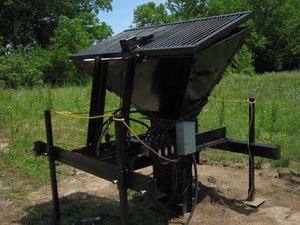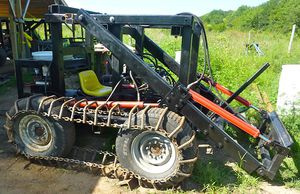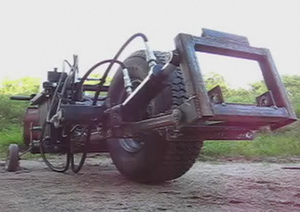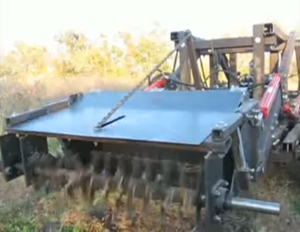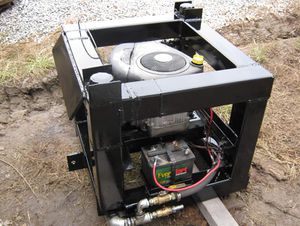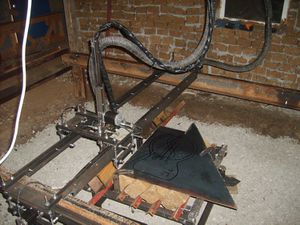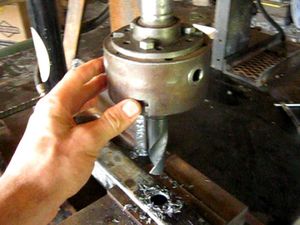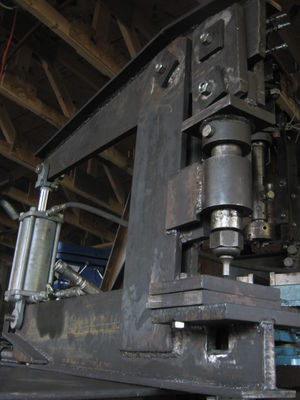Crash course on OSE/pl
| Krótki kurs o OSE Oto krótki kurs o Open Source Ecology (OSE). W czasie najbliższych 15 minut dowiesz się o wszystkich działaniach OSE w ciągu ostatnich 4 lat. Jeśli masz pytania wyślij e-mail na adres crashcoursemoderator (at) gmail.com. Zobacz także Podstawy techniczne GVCS. |
Przegląd dla nowych osób
Zacznij od naszej Strony głównej.
Aby zobaczyć czym się zajmujemy, obejrzyj wideo GVCS w 2 minuty. Open Source Ecology zostało założone w 2004 roku przez Marcina Jakubowskiego. Jesteśmy siecią farmerów, inżynierów i współpracowników, którzy od ponad 3 lat tworzą Globalny Zestaw Narzędzi do Budowy Samowystarczalnej Wioski (GVCS), otwartoźródłowej, niskokosztowej, wysoko wydajnej platformy technologicznej, pozwalającej na łatwe wyprodukowanie we własnym zakresie 50 różnych maszyn przemysłowych, niezbędnych do zbudowania samowystarczalnej cywilizacji o nowoczesnym komforcie.
GVCS obniża bariery przed wejściem w obszar rolnictwa, budownictwa oraz produkcji i może być postrzegany jako zestaw modularnych (na wzór klocków lego) narzędzi, które mogą stworzyć całkowicie nową gospodarkę, zarówno w rolniczych obszarach Missouri, gdzie projekt został założony, jak i na obszarach miejskich czy w sercu Afryki.
Mamy ambitny program ukończenia 49 pozostałych technologii w ciągu 2 lat i budżet wielkości 2,4 miliona dolarów - program ten nazywamy w skrócie programem 50/2/2.
We have an ambitious program for product release of the 49 remaining technologies within 2 years and a 2.4M dollars budget - which we abbreviate as our 50/2/2 program. The period for this is 2011-2012.
Kluczowe cechy GVCS
Oto Kluczowe cechy GVCS - jeśli chcesz zobaczyć pełny zestaw wartości zobacz Kluczowe wartości OSE.
Kluczowe cechy
|
Zakres GVCS
Zakres
|
Bieżący status
last updated: February 1, 2012.
See Status Brief (last updated 4/11/12) for latest technology development, and check the Flashy XM Platform for overall steps on organizational issues.
The following prototypes and products are developed until end of 2011:
| The Compressed Earth Brick (CEB) Press allows for rapid (16 brick per minute), low-cost, high-quality construction from on-site earth. The CEB Press is used to compress clayey soil (20-30% clay by volume) from local or on-site soils into structural masonry (700-1000 PSI) building blocks. Stabilization with cement may be used for additional weather resistance. CEB also lends itself to the construction of floors, paved areas, retaining walls, storage structures, or any other structures where a uniform, structural building block is desired.
Links: The Liberator, The CEB Story, initial field testing, pressing bricks, disassembly, crating (packaging), machine overview, the frame, the controller, CEB Machine Controller: Fabrication Recursion, Complete CEB Walkthrough. Documentation: Introduction, Build Instructions, CAD Files. Prototype I. Prototype II.Prototype III. Prototype IV | |
| LifeTrac is a versatile, 4-wheel drive, full-sized, hydraulically-driven, skid-steering tractor of 18-200 hp with optional steel tracks. LifeTrac is intended to be a minimalist but high-performance, lifetime design, design-for-disassembly workhorse and power unit of any land stewardship operation. It features easy serviceability by the user. Its modular nature allows for quick attachment of implements; interchangeability/stackability of multiple power units (Power Cubes) for adapting power level to the task at hand; quick attachment of all hydraulic components via quick-coupling hoses; including quick interchangeability of hydraulic motors for use in other applications.
Links: Prototype I; Prototype I with Power Cube; Prototype II of Development, Open Source Wheel tracks, Prototype II Complete, moving. Prototype III. Prototype IV. Documentation: Build (wiki page with videos), Blender Files; Quick Attach Plate and Tracks CAD | |
| MicroTrac is a scaled-down, walk-behind version of the the full-sized LifeTrac to address the need for a microtractor. We are using most of the same components as LifeTrac, except we are shrinking the structural members – to retain part interchangeability between MicroTrac and LifeTrac.
Links: Prototype I completed blog post, prototype I completed video, zero turn, Microtrac Prototype II, Prototype II Challenge. Documentation: wiki documentation ; Prototype I Blender File | |
| The Soil Pulverizer can be attached to LifeTrac and pulverizes the soil to a fine consistency which can be used in preparation for pressing Compressed Earth Bricks (CEBs).
Links: blog, construction and test (short video), test (video). | |
| The Power Cube is an universal, self-contained power unit that consists of an engine coupled to a hydraulic pump for providing power to different devices in the form of hydraulic fluid at high pressure. The Power Cube is a module that can be attached to the LifeTrac, Microtrac, Bulldozer, and Open Source Car (OSCar) platforms. It connects to other devices via quick couplers and quick-connect hydraulic hoses.
Links: Power_Cube_Prototype_I, Prototype II complete, Prototype II short fab video and Prototype II long fab video. Documentation: Blender Files. | |
| CNC Torch Table is a cutting table. A computer can control the torch head making clean sharp cuts on XYZ axes. Prototype I has been built, but has not been operated successfully because the radiation emitted by the plasma cutter that was used with the table caused electronics failure. We will finish Prototype I by retrofitting it with open source stepper motor controllers.
Links: wiki page, Plasma cutter in action, Open Source Torch Table Part 4, Part 5, Part 6. Documentation: Build (wiki), Blender File; Prototype I First Fire | |
| The Drill Press is for drilling 1″ and larger holes directly in metal without pre-drilling. It contains a hydraulic motor for the drilling and a hydraulic cylinder for the down pressure – so this is a literal press, and it is not short on torque or power as the motor can sustain up to 20 hp. We are using our Universal Rotor for the motor.
Links: video Documentation: documentation | |
| The Ironworker Machine is a device that can instantly cut steel and punch holes in metal thicknesses of 1". Currently the 150 Ton Hole Puncher is prototyped.
Links: 150 Ton Hole Puncher's blog post, Sketchup model Documentation: Hole Puncher's Wiki Documentation, Wiki Category |
In 2011, Marcin gave a TED Talk. We had product orders of the Power Cube, CEB Press, Tractor and Soil Pulverizer and we started with the construction of the HabLab and Workshop. Replications of the GVCS machines started.
We had a successful Kickstarter campaign and received grants from the Kauffman Foundation and Shuttleworth Foundation. Now we are expanding our Resource Development.
We are finishing the Civilization Starter Kit DVD containing full documentation of the Power Cube, CEB Press, Tractor and Soil Pulverizer
We are working now on 13 machines. You can see the current status and needs in the Status Brief.
You can preorder the GVCS machines.
Plany na przyszłość
2012 is rapid parallel development for the completion of the 50 machines. We are scaling our Organizational Development and recruiting a Co-Founder to join the team at Factor e Farm.
First we are planning to open source full beta products in three main groupings:
- The open source Microfactory package - Ironworker machine, CNC Torch Table, CNC Multimachine and Induction Furnace.
- Power Infrastructure Package - Modern Steam Engine, Pelletizer, Solar Concentrator, Heat Exchanger, Power Inverter.
- Construction Package - Well Drilling Rig, Sawmill, Backhoe, Bulldozer.
We are looking for active collaboration in all projects. Our current needs are:
- Fabrication Manager - finish the existing and continue new production runs, produce further construction equipment necessary for infrastructure buildout.
- Construction Project Manager- leading the building new of infrastructure as new people come on site, focusing on natural building techniques such as CEB, local lumber, and local biomass for superinsulation, and bioplastic for greenhouses (see last blog post for details)
- Project Managers – overall global/local project management and integration– utilizing the assistance of a global development team to move forward the creation and testing of the GVCS infrastructure at Factor e Farm
- Machine Designer/CAD – feeds technical design (CAD) into the prototyping process for the GVCS – by providing fabrication drawings to the fabrication team
- OSE Fabricators – custom fabricators and prototypers who convert technical design drawings into physical prototypes – creating the physical substance of the project
- CAM Expert – contributes to the CAM (fabrication automation) aspect of the prototyping process by developing CAM files and by using CNC machines – while streamlining the fabrication process
- Power Engineer – develops the electrical power grid for the community and develops the workshop power supplies – including developing the welder, plasma cutter, induction furnace, inverter, charge controller, and other power electric devices that are included in the GVCS
- Remote Collaboration Support – organizing remote contributor teams for design/CAD/prototyping assistance to Factor e Farm
- CAD/CAM Programmer – A robust, integrated, open source, professional-quality tool chain for CAD/CAM is currently not available. We will put effort into developing such a tool chain to promote the replicability of GVCS tools, by building on and integrating existing tools.
- Land Regeneration Manager – Factor e Farm suffers from serious erosion and fertility issues caused by decades of prior commercial row-cropping. To ameliorate this, our program calls for building berms, ponds, and other earthworks to address erosion directly, plus, extensive mulching, as well as intensive rotational grazing as a rapid way to improve the soil food web. The primary tools that are to be used in these tasks are bulldozers, ruminants, and hay-bales.
- Farmer – or more specifically – the open source agroecologist – the pivotal person in the community who provides nutrition to the FeF team and thereby is the primary contibutor to the good health of the community. The open source agroecologist is responsible for food production – from garden and orchard to field crops, animal husbandry, fishery, and forestry – and for food storage and processing, such as seed cleaning, seed saving, and oil expression. The farmer is responsible for producing food, fuel, and fiber crops (both wood and clothing) – while maintaining a diverse and integrated ecosystem and soil food web that improves in quality over time.
- Cook – feeds the FeF population; engages in crop planning, harvest, and organization of food processing activities
Marcin will give a TED talk on TED Global.
po 2013
After the GVCS completion the first OSE Community will be built and Education and Training in 2-year immersion program are planned.
A Documentary Film about Factory E Farm may come in the future.
Support OSE and collaborate with us to help us make this happen.
Przyłącz się
| Get yourself involved! If you liked what you've seen, please check the Get involved page to see the various ways you can contribute your time and skills to our project |
If you want to join quickly some of the project, then check the Guide to OSE Projects.
Media i wywiady
For Interviews, please check our Press Procedure. Here you can find High Resolution GVCS Media.
Kluczowe słowa
Informacje dla projektantów
- OSE Specifications
- Proposal 2012
- GVCS Development Template
- Product Template
- Development Team
- Wiki Policy
- Forum Policy
Inne
- Preorder the GVCS machines.
- Conferences
- Media Development
Najczęściej zadawane pytania
Do zrobienia
See GVCS Tasks and Project needs.
